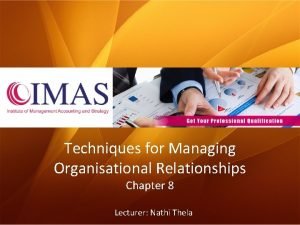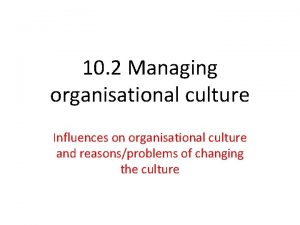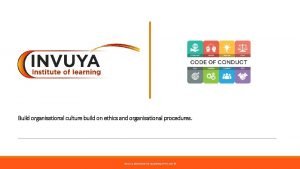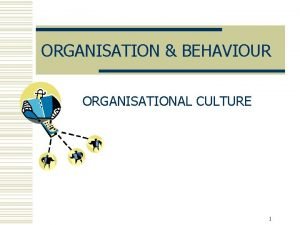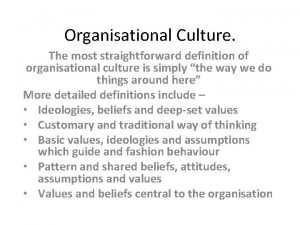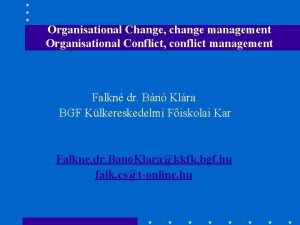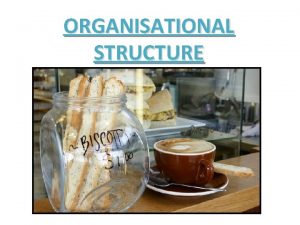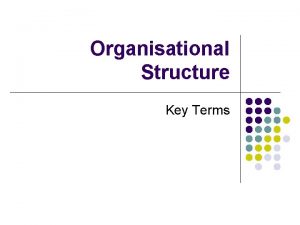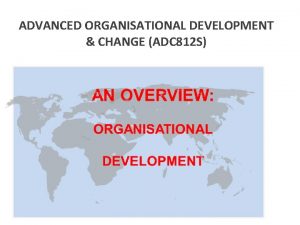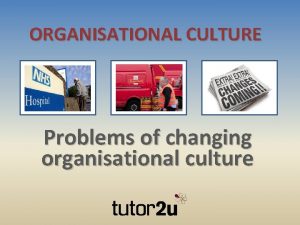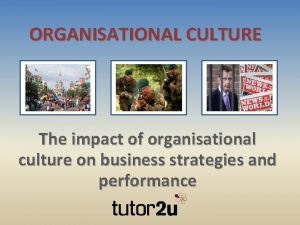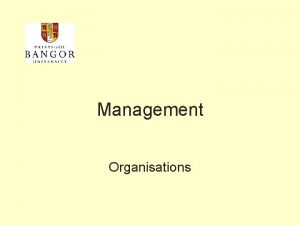Techniques for Managing Organisational Relationships Chapter 8 Lecturer















- Slides: 15

Techniques for Managing Organisational Relationships Chapter 8 Lecturer: Nathi Thela

Importance and Types of Communication Roles of CMA: 1. Formulation of policies and corporate objectives 2. Acquisition and use of finance 3. Generation, communication and interpretation of financial and operating information for management and other stakeholders 4. Derivation of performance measures 5. Improvement of business systems • • Types: – Formal communication – Informal communication Barriers: – Omissions – Jargon – Excessive information – Inappropriate medium – Unclear message Lecturer: Nathi Thela 2

Process of Communication Process used to transmit message from sender to receiver Encoding – process through which message is symbolised Channel – Medium through which message is sent Decoding – Process in which the message is translated and meaning is generated out of it. Noise: is anything that interferes with the communication process • Environmental Noise – physically disrupts communication • Physiological Noise – physical barriers (hearing loss, poor eyesight etc) • Psychological Noise –n Attitude of sender and reciever presents barrier to understanding • Semantic Noise - Sender & receiver have different understanding of words Lecturer: Roxanne Mingard 3

Barriers to Communication Barriers Sender: • Lack of clarity • Omitted information • Inappropriate or ambiguous words within message • Use of emotive words • Using technical jargon • Inappropriate medium • Sending too much information • Sending mixed messages Barriers Receiver: • Not in state to receive message • Message is unwanted • Selective hearing/understanding • Information overload • Mindset not aligned to details of message : Lecturer: Roxannecommunication Mingard Discuss non-verbal Ways to overcome barriers for Sender: • Have clear objective • Plan communication • Consider receiver's situation • Cater for anticipated reactions • Practice using channels of communication • Seek and work with the feedback Ways to overcome barriers for Receiver: • Consider their contribution • Listen attentively • Confirm any vague details • Give feedback 4

Meetings Steps of effective meetings: 1. Determine purpose of meeting 2. Establish who needs to attend 3. Determine agenda in advance 4. Make suitable arrangements for location & time 5. Facilitate discussion 6. Manage the plan of action 7. Summarise 8. Publish results/minutes Roles of team members: • Chairperson/facilitator • Administrator • Protagonists • Antagonists Lecturer: Roxanne Mingard Problems with meetings: • Inappropriate chairperson • Unclear objectives • Lack of structure and leadership • Hostility/lack of enthusiasm or interest • Wrong attendees • No action points • Inability to reach agreement • Action points from previous meeting not carried out • Minutes too long or too brief 5

Cialdini’s Six Principles of Influence Lecturer: Roxanne Mingard 6

Persuasion & Negotiation Persuasion is a stronger form of influence. While influence can be direct or indirect, intentional or unintentional, persuasion is always direct and intentional with the aim of changing a person, or group’s attitude or behaviour. Negotiation: • An activity that seeks to reach agreement between two or more starting positions – Interpersonal skills – Analytical skills Successful Negotiation: – Technical skills 1. Focus initially on each side’s primary objective. • Process 2. Be prepared to settle for fair – Preparation 3. Listen to other side wants and – Opening make efforts to compromise – Bargaining 4. Seek to trade-off wins and losses – Closing Lecturer: Nathi Thela 7

Negotiating Process Preparation Opening Bargaining Closing Lecturer: Nathi Thela 8

Types of Negotiation Lecturer: Nathi Thela 9

Conflict Mainwaring’s Causes of conflict: • History • Differences • Limited resources • Win/lose situations • Interdependencies • Misunderstandings • Conviction beliefs • Stress & failure • Change Daft’s Consequences to Conflict: 1. Diversion of energy 2. Altered judgement 3. Loser effects 4. Poor co-ordination Symptoms of Conflict: • Problems passed up the hierarchy due to unwillingness to take responsibility • Hostility & jealousy between groups • Poor communication • Frustration & dissatisfaction • Problems being polarised around people Lecturer: Nathi Thela 10

Conflict Horizontal Conflict – conflict between parties on same level. Sources: • Environment • Size • Technology • Structure • Goal incompatibility • Task interdependence • Reward systems • Differentiation Vertical Conflict – conflict between parties of different levels: • Power & Status • Ideology • Psychological distance • Scarce Resources Lecturer: Nathi Thela Constructive Conflict • Creates innovation & Change • Facilitates problem identification & solving • Settles & defines boundaries of authority Destructive Conflict: • Harmful for organisations & involved members • Causes alienation between groups & individuals 11

Thompson Kilman Conflict Mode Instrument (TKI) Different ways of handling conflict: • • • Lecturer: Nathi Thela Competing Avoiding Compromising Collaborating Accommodating 12

Mainwaring – Strategies for Managing COnflict 4 Strategies to Managing Conflict: 1. Conflict stimulation and orchestration encourage conflict for innovation 2. Conflict suppression use authority or force, a short-term strategy 3. Conflict reduction build on areas of agreement through compromise 4. Conflict resolution eliminate root cause of conflict by establishing consensus Methods to apply in organizational conflict are altering: • The issue in dispute • The proximity • Individuals involved • Lecturer: Separating out parts of the issue Roxanne Mingard Industrial Relations Conflict: • Unions highlight vertical conflict to even out power between labour and management where conflict is formalised by regulation. Tactics to reduce conflict with unions • Union avoidance strategies • Individualistic approaches • Collective bargaining New Approaches tend to be more co-operative: • Partnership agreements • Gain Sharing • Labour-management teams • Employment security 13

Managing Conflicts in Differing Goal • Bargaining – give and take • Satisficing – accepting satisfactory rather than maximum level performance • Sequential Attention – attending to important goals for a period of time before turning attention to other goals • Priority Setting – defining a preference ordering among goals Lecturer: Nathi Thela 14

Test Your Knowledge Stakeholders ?
 Lecturer's name
Lecturer's name Mainwaring conflict management
Mainwaring conflict management Physician associate lecturer
Physician associate lecturer Spe distinguished lecturer
Spe distinguished lecturer Good morning message to my lecturer
Good morning message to my lecturer Photography lecturer
Photography lecturer Lecturer in charge
Lecturer in charge Designation lecturer
Designation lecturer Designation of lecturer
Designation of lecturer Gcwak
Gcwak Lecturer name
Lecturer name Pearson lecturer resources
Pearson lecturer resources Spe distinguished lecturer
Spe distinguished lecturer Lector vs lecturer
Lector vs lecturer Lecturer in charge
Lecturer in charge Cfa lecturer handbook
Cfa lecturer handbook

